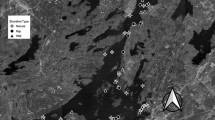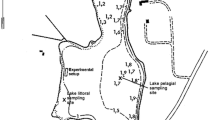Abstract
Mooring areas are a common form of berthing in many of Germany’s inland waters for the growing number of sporting boats. A circular swinging zone around the anchor zone is formed, in which the submerged macrophyte vegetation is destroyed to a large extent, and the sediment surface is eroded. We investigated the effects of two types of buoy (conventional and so-called hook-buoys) in comparison with undisturbed reference sites nearby. The aim of the study was to identify possible harmful consequences of mooring sites to lake littoral habitats in Lake Constance-Untersee, and to provide information to managers to aid them in the formulation of mooring management plans with the least ecological impact. The study focused on submerged vegetation, surface sediments and macro-invertebrate colonisation. In the swinging circle of conventional buoys (87 m2) we observed a significant sediment matter erosion of 0.9 tonnes and a reduction of organic matter amount by 4.5% of the undisturbed reference. The vegetation free area increased by 122%, and the phytomass (mainly Chara div. spp.) was reduced by 14.6% per berth. The psammophilous macro-invertebrate numbers were not significantly affected (−3%) in contrast to the phytophilous taxa which were reduced by 12.7% per berth. The mayfly larvae were the most negatively affected taxon. Oligochaetes profited from the clearing of the sediment surface in the swinging circles. The ecological effects of the hook-buoys were more minor, mainly due to the smaller swinging circle (6 m2). We concluded that the detrimental effects of mooring can be significantly reduced by mooring systems, e. g. the hook-buoy system as it was used in this study, which reduce the area disturbed and cleared by the anchor chain. We argue that these results can be generalised to mooring areas with soft bottom and dense macrophyte vegetation in Lake Constance and other large lakes.




Similar content being viewed by others
References
Armitage PD, Pardo I, Brown A (1995) Temporal constancy of faunal assemblages in “mesohabitats” application to management? Arch Hydrobiol 133:367–387
Bäuerle E, Ollinger D, Ilmberger J (1998) Some meteorological, hydrological, and hydrodynamical aspects of Upper Lake Constance. Arch Hydrobiol Spec Issues Advanc Limnol 53:31–83
Buttler KP, Harms K (1998) Florenliste von Baden-Wüerttemberg. Liste der Farn- und Samenpflanzen (Pteridophyta et Spermatophyta). Naturschutz-Praxis, Artenschutz, vol 1. Stuttgart, 486 pp
Creed JC, Amado Filho GM (1999) Disturbance and recovery of the macroflora of a seagrass (Halodule wrightii Ascherson) meadow in the Abrolhos Marine National Park, Brazil: an experimental evaluation of anchor damage. J Exp Mar Biol Ecol 235:285–306. doi:10.1016/S0022-0981(98)00188-9
Crowder LB, Cooper WE (1982) Habitat structural complexity and the interaction between bluegill and their prey. Ecology 63:1802–1813. doi:10.2307/1940122
Danell K, Sjöberg K (1980) Foods of wigeon, teal, mallard and pintail during summer in a northern Swedish lake. Swed Wildl Res Viltrevy 11:141–167
Diehl S (1992) Fish predation and benthic community structure:the role of omnivory and habitat complexity. Ecology 73:1646–1661. doi:10.2307/1940017
Francour P, Ganteaume A, Poulain M (1999) Effects of boat anchoring in Posidonia oceanica seagrass beds in the Port-Cros National Park (north-western Mediterranean Sea). Aquat Conserv 9:391–400. doi:10.1002/(SICI)1099-0755(199907/08)9:4<391::AID-AQC356>3.0.CO;2-8
Gerking SD (1957) A method of sampling the littoral macrofauna and its application. Ecology 38:219–226. doi:10.2307/1931680
Gilinsky E (1984) The role of fish predation and spatial heterogeneity in determining benthic community structure. Ecology 65:455–468. doi:10.2307/1941408
Giller PS, Malmqvist B (1999) The biology of streams and rivers. Oxford University Press, Avon, 296 pp
Hanson JM, Legett WC (1982) Empirical prediction of fish biomass and yield. Can J Fish Aquat Sci 39:257–263. doi:10.1139/f82-036
Hastings K, Hesp P, Kendrick G (1995) Seagrass loss associated with boat moorings at Rottnest Island, Western Australia. Ocean Coast Manage 26:225–246. doi:10.1016/0964-5691(95)00012-Q
Heino J (2000) Lentic macroinvertebrate assemblage structure along gradients in spatial heterogeneity, habitats size and water chemistry. Hydrobiologia 418:229–242. doi:10.1023/A:1003969217686
Hoffmann RL, Liss WJ, Larson GL, Deimling EK, Lomnicky GA (1996) Distribution of nearshore macroinvertebrates in lakes of the Northern Cascade Mountains, Washington, USA. Arch Hydrobiol 136:363–389
IGKB (Internationale Gewässerschutzkommission für den Bodensee) (2005) Auswertung der Statistik der Schifffahrtsanlagen für 2003. http://www.igkb.de
Keast A (1984) The introduced aquatic macrophyte, Myriophyllum spicatum, as habitat for fish and their invertebrate prey. Can J Zool 62:1289–1303
Keast A (1985) Planktivory in a littoral-dwelling fish association, prey selection and seasonality. Can J Fish Aquat Sci 42:1114–1126
Krause W (1997) Charales (Charophyceae). In: Süesswasserflora von Mitteleuropa, vol 18. Fischer, Jena, 202 pp
Krull JN (1970) Aquatic plant-macroinvertebrate associations and waterfowl. J Wildl Manage 34:707–718. doi:10.2307/3799135
Laughlin DR, Werner EE (1980) Resource partitioning in two coexisting sunfish: pumpkinseed (Lepomis gibbosus) and northern longear sunfish (Lepomis magalotis peltastes). Can J Fish Aquat Sci 37:1411–1420
Lenihan HS, Oliver JS, Stephenson MA (1990) Changes in hard bottom communities related to boat mooring and tributyltin in San Diego Bay California USA: a natural experiment. Mar Ecol Prog Ser 60:147–160. doi:10.3354/meps060147
Marba N, Duarte C, Holmer M, Martinez R, Basterretxea G, Orfila A, Jordi A, Tintore J (2002) Effectiveness of protection of seagrass (Posidonia oceanica) populations in Cabrera National Park (Spain). Environ Conserv 29:509–518. doi:10.1017/S037689290200036X
Milazzo M, Badalamenti F, Ceccherelli G, Chemello R (2004) Boat anchoring on Posidonia oceanica beds in a marine protected area (Italy, western Mediterranean): effect of anchor types in different anchoring stages. J Exp Mar Biol Ecol 299:51–62. doi:10.1016/j.jembe.2003.09.003
Minshall GW (1984) Aquatic insect-substratum relationships. In: Resh VH, Rosenberg DM (eds) The ecology of aquatic insects. Praeger, NY, pp 358–400
Mittelbach GG (1984) Predation and resource partitioning in two sunfishes (Centrarchidae). Ecology 65:499–513. doi:10.2307/1941412
Murkin HR, Kadlec JA (1986) Relationships between water fowl and macroinvertebrate densities in a northern prairie marsh. J Wildl Manage 50:212–217. doi:10.2307/3801899
Pieczynski E (1973) Experimentally increased fish stock in the pond type Lake Warniak XII Numbers and biomass of the fauna associated with macrophytes. Ekol Pol A 11:533–545
Rabe FW, Gibson F (1984) The effect of macrophyte removal on the distribution of selected invertebrates in a littoral environment. J Freshwat Ecol 2:359–371
Rasmussen JB (1982) The influence of thermal effluent, before and after macrophyte harvesting, on standing crop and species composition of benthic macroinvertebrate communities in Lake Wabamun, Alberta. Can J Zool 60:3196–3205. doi:10.1139/z82-405
Rasmussen JB (1988) Littoral zoobenthic biomass in lakes, and its relationship to physical, chemical, and trophic factors. Can J Fish Aquat Sci 45:1436–1447
Schmieder K, Werner S, Bauer H-G (2006) Submersed macrophytes as a food source für wintering waterbirds at Lake Constance. Aquat Bot 84:245–250. doi:10.1016/j.aquabot.2005.09.006
Søndergaard M, Bruun L, Lauridsen T, Jeppesen E, Madsen TV (1996) The impact of grazing waterfowl on submerged macrophytes: in situ experiments in a shallow eutrophic lake. Aquat Bot 53:73–84. doi:10.1016/0304-3770(95)01013-0
Soszka GJ (1975) The invertebrates on submerged macrophytes in three Masurian lakes. Ekol Polska 23:371–391
Szijj J (1965) Ökologische Untersuchungen an Entenvögeln (Anatidae) des Ermatinger Beckens (Bodensee). Vogelwarte 23:24–70
Tolonen KT, Hämaläinen H, Holopainen IJ, Karjalainen J (2001) Influences of habitat type and environmental variables on littoral macroinvertebrate communities in a large lake system. Arch Hydrobiol 152:39–67
van Donk E, De Deckere E, Klein-Breteler JGP, Meulemanns JT (1994) Herbivory by waterfowl and fish on macrophytes in a biomanipulated lake: effects on long-term recovery. Verh Int Ver Limnol 25:2139–2143
Vincent B, Lafontaine N, Caron P (1982) Facteurs influençant la structure de groupement de macro-invertébrés benthiques et phytophiles dans la zone littorale du Saint-Laurent (Québec). Hydrobiologia 97:67–73. doi:10.1007/BF00014959
Wade PM (1999) The impact of human activity on the aquatic macroflora of Llangorse Lake, South Wales. Aquat Conserv 9:441–459. doi:10.1002/(SICI)1099-0755(199909/10)9:5<441::AID-AQC359>3.0.CO;2-J
Walker DI, Lukatelich RJ, Bastyan G, McComb AJ (1989) Effect of boat moorings on seagrass beds near Perth Western Australia. Aquat Bot 36:69–78. doi:10.1016/0304-3770(89)90092-2
Ward JV (1992) Aquatic insect ecology: 1 Biology and habitat. Wiley, New York, 438 pp
Acknowledgements
We wish to thank Christof Stier for his assistance during field sampling, Marc Hamitou for enumeration and determination of difficult taxa, two anonymous reviewers for helpful comments, and Rachel Kemp for linguistic corrections. We are also indebted to Martin Wessels at the Institute for Lake Research, Langenargen for making the grain size analyses. The study was partly funded by the Plenum Westlicher Bodensee programme.
Author information
Authors and Affiliations
Corresponding author
Rights and permissions
About this article
Cite this article
Ostendorp, W., Gretler, T., Mainberger, M. et al. Effects of mooring management on submerged vegetation, sediments and macro-invertebrates in Lake Constance, Germany. Wetlands Ecol Manage 17, 525–541 (2009). https://doi.org/10.1007/s11273-008-9128-0
Received:
Accepted:
Published:
Issue Date:
DOI: https://doi.org/10.1007/s11273-008-9128-0




